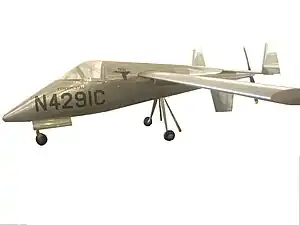| Lesher Teal | |
|---|---|
 | |
| Lesher Teal | |
| Role | Homebuilt aircraft |
| National origin | United States |
| Designer | Edgar J Lesher |
| First flight | 28 April 1965 |
| Number built | 1 |
The Lesher Teal is a home built experimental aircraft that at one point held seven Federation Aeronautique Internationale (FAI) class is C-l.a records for speed and distance.
Design and development
The Teal was designed to beat the Federation Aeronautique Internationale (FAI) class is C-l.a records for speed and distance.
Construction started in 1962. The aircraft was configured as an all-aluminum single-place aircraft with retractable landing gear, powered by a 100 hp Continental O-200 engine driving a 64-inch Hartzell ground-adjustable propeller.[1] By 28 April 1965, the airframe was complete. On that day, Lesher made the aircraft's first flight at Willow Run Airport. That August, he flew Teal to the 1965 EAA Fly-In in Rockford, Illinois, where he won an award from the EAA for his achievements.
Operational history
After two years of testing the Teal, Lesher flew the aircraft, on 22 May 1967, to a new 500 km closed-course Class C1a speed record of 181.55 mph. On 30 June 1967, he set a new 1,000 km closed-course speed record of 169.20 mph and on 220 October 1967, he set a new 2,000 km closed-course speed record of 141.84 mph.[2]
On 6 May 1968, while flying Teal near Ann Arbor, he experienced a loss of power. Not being able to make it to a nearby airport, he made an emergency landing in a field. The airplane was badly damaged, but he was unhurt.[2] After rebuilding Teal, on 9 September 1970, he set a new Class C1a closed-circuit distance record of 1554.29 miles.[3] Later, on 29 September 1973 he set a new Class C1a 3 km speed record of 173.101 mph and the next day he set a new 15–25 km speed record of 169.134 mph.[4] Finally, on 2 July 1975, he set a new Class C1a record for distance in a straight line by flying 1,835.459, flying from Florida to Arizona.[5] He continued to fly Teal for many more years, but never made any more record attempts. For his record-breaking flights, he won the FAI's Louis Bleriot Medal four times[6] and was inducted in the Michigan Aviation Hall of Fame in 1988.[7]
The Teal was donated to the EAA Airventure Museum in 2002.[8]
Specifications (Lesher Teal)
Data from Jane's All the Worlds Aircraft 1967–68.[9]
General characteristics
- Length: 19 ft 3 in (5.87 m)
- Wingspan: 23 ft 10 in (7.26 m)
- Height: 5 ft 8 in (1.73 m)
- Wing area: 60.0 sq ft (5.57 m2)
- Aspect ratio: 9.6:1
- Airfoil: NACA 653618
- Empty weight: 685 lb (311 kg)
- Max takeoff weight: 1,102 lb (500 kg)
- Fuel capacity: 60 US gal (50 imp gal; 230 L)
- Powerplant: 1 × Continental O-200A-A air-cooled four-cylinder horizontally-opposed piston engine, 100 hp (75 kW)
- Propellers: 2-bladed Hartzell, 5 ft 4 in (1.63 m) diameter (ground-adjustable pusher)
Performance
- Cruise speed: 160 kn (180 mph, 290 km/h) (70% power)
- Stall speed: 70 kn (80 mph, 130 km/h)
- Range: 1,700 nmi (2,000 mi, 3,200 km)
See also
Aircraft of comparable role, configuration, and era
References
- ↑ Lesher, Edgar J., "Teal", EAA Sport Aviation, March 1968.
- 1 2 Pellegreno, Ann Holtgren, "Professor Lesher, Record-Setter", Air Trails Homebuilt Aircraft, Summer 1970
- ↑ Lesher, Edgar J., "Teal Progress Report", EAA Sport Aviation, February 1970.
- ↑ Lesher, Edgar J., "Connecticut Sojourn", EAA Sport Aviation, June 1974.
- ↑ Lesher, Edgar J., "Teal Trek", EAA Sport Aviation, February 1976.
- ↑ Obituaries Ann Arbor News 22 May 1998
- ↑ Enshrinees Archived 3 November 2011 at the Wayback Machine Retrieved 27 July 2011.
- ↑ Lesher Teal – N4291C Archived 4 September 2010 at the Wayback Machine Retrieved 27 July 2011.
- ↑ Taylor 1967, pp. 283–284
- Taylor, John W. R. (1967). Jane's All The World's Aircraft 1967–68. London: Sampson Low, Marston & Company.